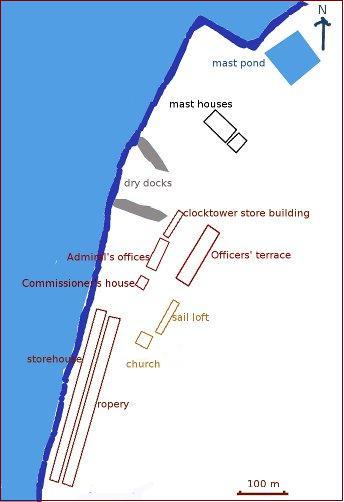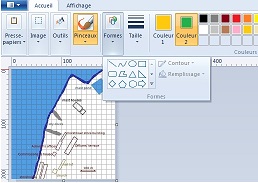Dockyards: diagrams
Conditions d’achèvement
![]() If you need definitions of the different types of exercises or activities to be submitted on moodle, look at the User's Guide.
If you need definitions of the different types of exercises or activities to be submitted on moodle, look at the User's Guide.
The text below is a 'read-only' question; it is meant to give visitors an idea of possible exercises. Registered students should click on the 'Submission' button available to them in order to move to the exercise page and write or attach their contribution.

- Documents:
- Study the section on Chatham Dockyards on the Georgian Cities website; save the diagram of Chatham Dockyards above (to save an image on the web, right-click on it and select 'Save the image' in the pop-up menu), then open it in image editing software - you will need the same paint program and tools as for the exercises in Unit 1 - see thumbnail:

- open the photo of the 1774 wooden model of the dockyard at the National Maritime Museum mentioned on Georgian Cities page
- Activity:
- compare the two documents; with a paint programme, edit the diagram so as to show the difference between the buildings already existing in 1774 (as shown in the model) and those built afterwards.
- indicate the coding you choose to mark the chronology, and comment on your work; explain what it reveals about the history of the dockyard.
Skills:
- comparison between visual documents
- sense of chronology
- drawing and visual coding
Background: information visualisation
- diagram coding: colour coding inherited from Vauban (a 17th-century French military engineer), who coloured in yellow the proposed parts of buildings to distinguish them from the existing parts; similar colour coding is used in some of the Dockyards models.
- models:
*wooden architectural models had existed for a long time for major buildings such as cathedrals
- as architectural models: see the model of Brunelleschi's cupola of the Duomo in Florence in the Museo dell'Opera di Santa Maria del Fiore (1420-1440, 99 x 94 cm), and Wren's model of one of the projects for St Paul's Cathedral in St Paul's (1673-74, scale 1/25)
- there were also models of cities and military places (Museo Storico Navale in Venice, Musée des Plans Reliefs in the Invalides in Paris)
- as reconstructions of the past: Soane's cork models of ancient buildings (late 18th-early 19th c)
* dolls' houses were decorative objects for adults to be placed in the reception rooms and toyed with by the lady of the house; fully furnished, the models would sometimes cost as much as the house itself